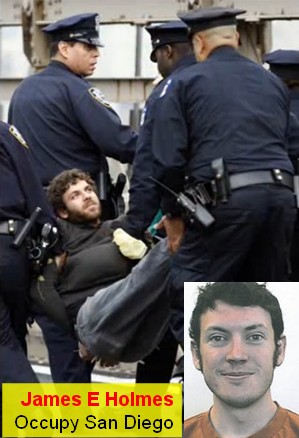July 29, 2012
This was posted at: http://anoncentral.tumblr.com/post/28109989079/colorado-massacre-linked-to-historic-bank-fraud
Colorado Massacre Linked To Historic Bank Fraud - Killer Does Not Appear To Be James Holmes
KILLER DOES NOT APPEAR TO BE JAMES HOLMES - JAMES HOLMES BEING USED IN BLACKMAIL OF ROBERT HOLMES FINANCIAL FRAUD DETECTION EXPERT FOR FICO IN LIBOR SCANDAL.
James Holmes father Robert Holmes, was said to have been scheduled to testify within the next few weeks before a US Senate panel on the massive banking crime called the LIBOR Scandal where UK banks fixed the London Interbank Borrowing Rate with the complicity of the Bank of England, the US Federal Reserve (which knew about this crime for 4 years and didn’t report it) and many other major Western banks.
Not known to the majority of those affected by this LIBOR rate scandal (which is everyone in the world) is that its historically low setting of interests rates since the beginning of the Global Financial Crisis of 2007-2012 has done more to destroy the life savings, stock investments and retirements of Americas middle class than any other single event in their entire history.
Even worse, according to this report, Holmes recently completed his work on what is called one of the most sophisticated computer algorithms ever developed that not only uncovered the true intent of this massive fraud, but is, also, able to trace the Trillions of Dollars “lost” to the exact bank accounts of the elite classes who have stolen it.
This Colorado massacre occurred within minutes of London’s Guardian News Service releasing report this past Saturday (21 July) titled “Wealth Doesn’t trickle Down – It Just Floods Offshore, Research Reveals” as Robert Holmes algorithms [AI neural networks] were said used to discover this massive fraud scheme.
Equally curious to note about this massacre is that the American intelligence website TheIntelHub.Com in their 23 July article titled “Hallmarks of a False Flag: Colorado University Held Identical Drill on Same Day as Aurora Theater Mass Shooting, Mind Control, and Multiple Suspects” states that just mere hours before this shocking crime was committed the Rocky Vista University College of Osteopathic Medicine was holding an identical drill that simulated a shooter in a movie theater.
“False flag” events such as the Colorado massacre are actively planned for by the US Army as noted in their training manual titled “Foreign Internal Defense Tactics Techniques and Procedures for Special Forces”.
Ben Swann from their WXIX-FOX19 station out of Cincinnati, Ohio, who asks:
“Why did Holmes go to the expense and trouble of rigging his apartment with an array of deadly explosives and then immediately tell police about the bombs when he was arrested? If Holmes wanted to kill as many people as possible, why warn the cops ahead of time?
Given the fact that Holmes was a graduate student in neuroscience, where did he obtain the skills to create a maze of bombs so complex that it took the FBI two days to disarm them? According to experts, the intricacy of the bombs was reminiscent of war zones – how could Holmes have set all this up without help from an explosives expert?
Despite police claiming “every single indicator” tells them the shooting was a lone wolf attack, numerous witnesses have described accomplices. Initial police reports that suggested the involvement of two or more shooters were quickly buried and the lone wolf narrative aggressively pushed.
As Swann points out, eyewitnesses interviewed after the shooting such as Corbin Dates state that Holmes received a phone call from someone while he was inside the theater and responded by moving to the emergency exit, suggesting the call was an accomplice coordinating the attack.
Dates also said he saw Holmes by the exit door “signaling somebody or looking for somebody to come his way.
Another eyewitness added, “From what we saw he wasn’t alone – he had someone with him. Because the second can of tear gas didn’t come from his side.”
The real James Holmes apparently has been abducted (compare photos) to force FICO crime scientist Robert Holmes to not testify in LIBOR scandal — his expertise as scienfiic director at FICO investigating fraud by statistical patterns and expert in credit scoring analysis -
The real James Holmes is on the right [Terran Note: This appears to be a typo, the real James is on the left as in the photo above]. This imposter is on assignment and somehow has been assured of protection and is a pure sociopath earning a buck. If the real James Holmes has been taken then his parents, of course, know it.
James’ father is a mathematician/statistician who works for FICO which scores our credit using among other things the inter-bank interest rate set by LIBOR. FICO is the eyes, the intelligence of lenders in discriminating among potential borrowers as risks. James Holmes was the lead developer of FICO’s fraud manager system for financial institutions. [He is also one of the leading San Diego researchers on neural network based artificial intelligence systems.]
The LIBOR scandal which involves the biggest and most powerful merchant banking houses in the City of London is in the midst of the biggest fraud scandal in history. Here is money and motive enough to make conceivable a black-operation on the scale of the James Holmes frameup.
James’ father is a mathematician/statistician who works for FICO which scores our credit using among other things the inter-bank interest rate set by LIBOR. FICO is the eyes, the intelligence of lenders in discriminating among potential borrowers as risks. James Holmes was the lead developer of FICO’s fraud manager system for financial institutions. [He is also one of the leading San Diego researchers on neural network based artificial intelligence systems.]
The LIBOR scandal which involves the biggest and most powerful merchant banking houses in the City of London is in the midst of the biggest fraud scandal in history. Here is money and motive enough to make conceivable a black-operation on the scale of the James Holmes frameup.
The bankers are major criminals and have been for sometime. They are criminals with trillions at their disposal. They control all strategic institutions of probably all major governments or are working towards that end. They need to know that no man in law enforcement or fraud detection can harm them, and so they have prepared means of intervening to prevent — by murder, blackmail, intimidation, bribery or psychological manipulation by methods developed in secret by the former Soviet Union, China, Israel and the officially denied equally unrestrained CIA and also mercenary intelligence and espionage services retained by high financial organized crime. What I am driving at is that operations like this may be on stand-by for any fraud investigator or honest politician or financial expert the banks legitimately employ. James Holmes may have been targeted early as the handle by which to control Robert Holmes if that is necessary.
Robert Holmes knows which of these to is his son and which is not.
Not only is the arm of the international banking crime syndicate able to reach out and stop investigating statistician-mathematician -operations-analysis fraud investigators like Robert Holmes - they are also, very easily, able to keep police and defense attorneys from following the right lines of evidence. The resources to intimidate or bribe or otherwise control person after person to prevent an outcome or to force an outcome certainly exists, certainly is part of the defensive equipment of the most powerful criminal syndicate the world has seen.
The only defense the people have against the banking crime families is for the public to spread the word and all as one speak with a unified voice of public opinion. But of course the bankers can thwart that, as they have with 9-11, with the economic depression, with countless other crimes too big and too amazing even to believe when they are all listed on one page. (for example, weaponized weather modification and the ability to take control of planes. The fact that the prisoner in the Aurora shooting is not James Holmes. That a crime this elaborate and expensive could only be performed in the interests of the most powerful people on the planet — and they are the international bankers to whom this one country owe 14 trillion dollars — a good portion of which figure was determined by fraudulent manipulations of the LIBOR (inter-bank exchange rate) which has been set to favor the bankers rather than to reflect currently obtaining lending market conditions as it is represented as doing. This crime could spell the end of the international bankers — and that is why they went to such lengths to kidnap James Holmes and substitute this mass-murdering imposter in his place — and who we may shortly be hearing killed himself — I can’t see how they can let him go on public trial, or appear with his hair dyed back to its original color.
Holmes father:
Robert went on to earn a bachelor’s degree in mathematics at Stanford, a master’s in biostatistics at UCLA, and a doctorate in statistics at the University of California at Berkeley in 1981. His doctoral thesis was titled “Contributions to the Theory of Parametric Estimation in Randomly Censored Data.” He subsequently authored studies for the Navy and the Marine Corps on how to forecast personnel changes using something called “tree classifications,” the trees in question being statistical. Eventually, reports say, he signed on as a low-six-figure-a-year senior scientist with FICO, which produces management systems, fraud protection, and credit scores



